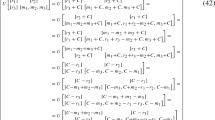Abstract
Algorithms are developed for computing generalized Racah coefficients for the U(N) groups. The irreducible representations (irreps) of the U(N) groups, as well as their tensor products, are realized as polynomials in complex variables. When tensor product irrep labels as well as a given irrep label are specified, maps are constructed from the irrep space to the tensor product space. The number of linearly independent maps gives the multiplicity. The main theorem of this paper shows that the eigenvalues of generalized Casimir operators are always sufficient to break the multiplicity. Using this theorem algorithms are given for computing the overlap between different sets of eigenvalues of commuting generalized Casimir operators, which are the generalized Racah coefficients. It is also shown that these coefficients are basis independent.
Similar content being viewed by others
References
Aulwes, R. T., Klink, W. H. and Ton-That, T.: J. Phys. A 34 (2001), 8237.
Godement, R.: Introduction a la theorie des groupes de Lie, Publ. Math. Univ. Paris, Universite de Paris VII, Paris, 1982, Theorem 2, p. 580.
Multiplicity can be computed using Steinberg’s formula, see Humphreys, J.: Introduction to Lie Algebras and Representation Theory, Springer-Verlag, Berlin, 1972, page 141.
Klink, W. H. and Ton-That, T.: J. Phys. A 21 (1988), 3877.
Klink, W. H. and Ton-That, T.: J. Funct. Anal. 84 (1989), 1.
Klink, W. H. and Ton-That, T.: J. Comput. Phys. 80 (1989), 453.
Klink, W. H. and Ton-That, T.: J. Algebra 145 (1992), 187.
Klink, W. H., Ton-That, T. and Wills, R. D.: J. Phys. A 26 (1993), 3229.
Borel Weil theory is discussed in Knapp, A.: Representation Theory of Semisimple Lie Groups, Princeton University Press, Princeton, NJ, 1986, page 143.
See for example, Thompson, W. J.: Anglular Momentum, An Illustrated Guide to Rotational Symmetries for Physical Systems, Wiley-Interscience, New York, 1994, a text that is accompanied by a diskette for comuting various SU(2) coefficients.
See for example, Varshalovich, D. A., Moskalev, A. N. and Khersonskii, V. K.: Quantum Theory of Angular Momentum, World Scientific Publishing, Singapore, 1988.
Author information
Authors and Affiliations
Corresponding author
Additional information
Mathematics Subject Classifications (2000)
22E70, 81R05, 81R40.
Rights and permissions
About this article
Cite this article
Gliske, S., Klink, W.H. & Ton-That, T. Algorithms for Computing Generalized U(N) Racah Coefficients. Acta Appl Math 88, 229–249 (2005). https://doi.org/10.1007/s10440-005-8345-2
Received:
Accepted:
Issue Date:
DOI: https://doi.org/10.1007/s10440-005-8345-2



